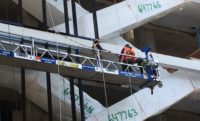Update
The History Books Never Really Close on Construction

The advent of magazine photography brought ENR to visual life starting in the early 20th century.
Cover from ENR Archives
One thing that jumps out at me from reading ENR’s yearlong series celebrating our 150th anniversary is the perspective it affords us about construction and journalism.
Written by recently retired ENR Research Director Scott Lewis, the series showed me that the creation and perfection of our built environment reflects a century-and-a-half of resourceful endeavors. A turning point for the publication however, came with the advent of magazine photography, which began in a German magazine in 1901. The addition of photographs brought visual life to ENR’s coverage, allowing the magazine in 1926 to show workers inside a wooden stave pipe under construction at a hydroelectric plant on the Klamath River. In 1944, ENR’s cover showed one of the first declassified images of a portable Bailey Bridge, which proved invaluable to the Allies in World War II.
Another thing that jumps out at me was the impulse of former ENR editor and engineer Arthur Wellington, described in a thoughtful article by Lewis, to investigate accidents for the lessons they could teach engineers in the late 19th century. Indeed, ENR was an active part of the refining of engineering and construction methods of railroads and foundation construction.
The first such instance, Lewis wrote, was a March 1887 railway disaster where a Boston bridge collapsed as a commuter train was crossing it, killing 38 people. After hearing the news, Wellington dispatched a New York bridge engineer to Boston to learn the cause. There the ENR correspondent found “the pair of broken floor-beam hangers whose failure had caused the disaster.”
Since then, construction and journalism have changed. The worldwide industry is bigger, highly segmented and specialized. It remains at once localized—general contractors often rely on local subcontractors—and yet the general coordination of bigger projects are increasingly performed by large construction corporations. Concern for the environment is now paramount, while at the same time areas of the world still lack safe water and reliable electrical power. How funds are spent and who is affected is considered more broadly.
And ENR no longer is written by and for engineers exclusively. We remain obsessively devoted to those who design and construct the built environment. But we are no longer an academic journal of engineering, as Lewis has noted. Instead, we reflect the widely diversified industry. Our coverage and mainstay company rankings and cost data, our project competitions and award programs, are used by executives, estimators, human resource managers, risk managers, safety staff, attorneys, suppliers and marketers. Public works officials read us. So do union leaders. Our stories are seen by the general public, too, whose well-being is also uppermost in our minds. We try to tie this loose confederation of sometimes feuding constituencies together. And we are much more dependent on you, our audience, to know what’s important and what you need, than was ever imagined by those who established this publication 150 years ago.




